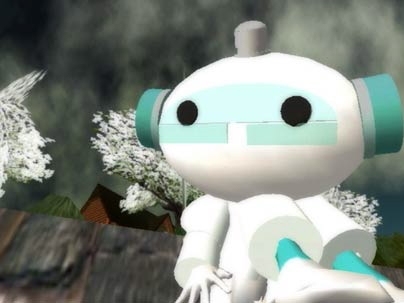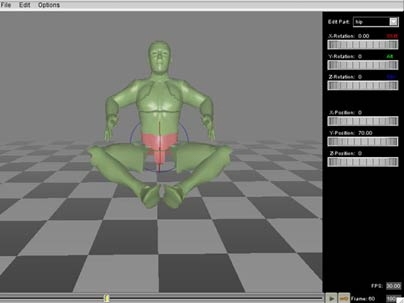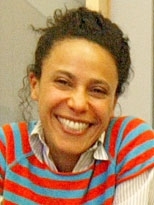Student researchers working with Beth Coleman, assistant professor in comparative media studies and in the Program in Writing and Humanistic Studies, are exploring machinima, one branch of the rapidly evolving world of computer animation. As members of the Machinima Work Group, they are experimenting in the medium to find new modes of cinematic expression.
Machinima (pronounced "machine-ima," the word is coined from "machine" and "cinema") is animation that is made by harnessing 3-D game engines, such as those used in Xbox or PlayStation games, and adding original content--dialogue, dramatic situations, and new or modified characters. Relative to traditional computer-generated imagery (CGI), in which animators must create the characters, scenes (levels) and action from scratch, machinima is fast and cheap--though still enormously time-consuming. The most well-known work of machinima to date is "Red vs. Blue," a comic sci-fi series based on the popular Xbox games Halo and Marathon. But many, including Coleman's group, are working to expand the medium above and beyond the genre of parody and to gauge its potential for artistic and cinematic expression.
Coleman explained in a recent interview that the medium has really exploded in the past five years, to the point where you now see ads on television that are made in machinima.
"It's popular because it's inexpensive and faster," she said, "but also there's a preference for the style of video games for this generation." People who grew up playing Quake and Doom feel comfortable in virtual game spaces and are stimulated by the possibility of manipulating them. They find, though, that machinima film-making has many of the same constraints and requirements as other kinds of film-making: You still have to write a script, develop the characters, make the storyboards, and edit and re-edit the work.
Katherine Kuan, an electrical engineering and computer science major at MIT, has been working on the machinima project since February. Said Kuan, "It started out slow, building characters on my own in Second Life," a virtual world in which people create their own "avatars" and can spend real money to buy virtual sets, costumes, or scripts from other "residents." She enjoys working in Second Life: "It's very flexible, you can build whatever you like, and it's kind of like real film production."
This October, Coleman organized a couple of two-day "cross-university" tutorials to bring interested parties up to speed on the tools and relative merits of two different 3-D engines, UT (Unreal Tournament 2004) and Second Life. "We've done some experimenting as our own production group," said Coleman, "now we're getting together with other people."
Participants included two design students from Parsons Design School, Mikhail Akopyan and Jenny Yi-Chen, who came up from New York City especially for the tutorial, as well as Kuan. Rodica Buzescu, a Harvard graduate who manages the Second Life presence of the Berkman Center for Internet and Society at Harvard Law School, gave the group the benefit of her extensive experience "in-world." Among the issues addressed: how to get hair to flow naturally and how to make trees.
The participants came from diverse perspectives and backgrounds. While Kuan approached it from a programming background, Akopyan is a sculpture student who has used game engines to produce not animation but sculpture "without material and physical constraints." Although his interests "lean away from the technical," he found the project exciting and worth the trip from New York. Buzescu, meanwhile, noted that "Machinima is just one of my interests. I used to run a group in-world for people with Asperger Syndrome, using Second Life as a place to practice their social skills."
As the tutorial proceeded, scenes from the Machinima Work Group animation, whose working title is "Boba Fett's Day Off," popped up on Buzescu's laptop. A cement living space hovered in the air above a green landscape, where a puffy white robot mingled with a couple of slim, well-dressed women. "Hey," Coleman remarked, "the basement is floating."
"Why not?" answered Buzescu. "There's no gravity."
The machinima project has had the support of generous grants from the MIT Council for the Arts and the SHASS Dean's Fund.
A version of this article appeared in MIT Tech Talk on November 1, 2006 (download PDF).








